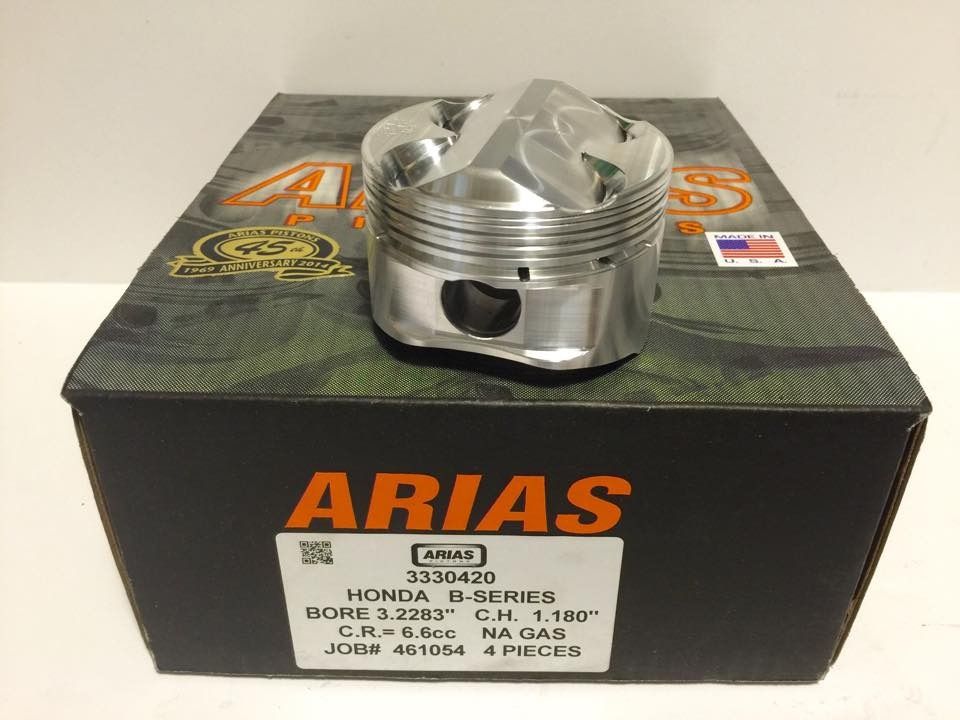Arias Pistons 12.5:1 Compression 82mm Bore Honda B-series on 2040-parts.com
Orlando, Florida, United States
 Categories WHY CHOOSE US  Arias Pistons 12.5:1 Compression 82mm bore Honda B-Series  hello hello Description Honda/Acura B18c1 DOHC VTEC 1.8L Stock Bore: 82mm Stroke: 3.433 Rod: 5.430 Head CC: 41.6 Gasket: .028 Deck: .005 Compression Height: 1.180 Dome CC: 6 Compression Ration with Stock Head: 12.5:1 Required Ring set: 1012303228 Payment is accepted only through Paypal. We will only ship to the Paypal confirmed shipping address. Payment for orders should be made within 5 business days. Sales tax will be charged for orders from Florida. If you require another payment arrangement, please contact us by email or eBay seller messages. You may also like this |
Pistons & Piston Rings for Sale
 Sealed power 9224-35 file fit plasma moly piston ring set 4.350 inch bore(US $155.95)
Sealed power 9224-35 file fit plasma moly piston ring set 4.350 inch bore(US $155.95) Diamond forged pistons sbc 6" rod dome 4.155 bore used 400 .030 406
Diamond forged pistons sbc 6" rod dome 4.155 bore used 400 .030 406 Diamond pistons sbc sbx(US $400.00)
Diamond pistons sbc sbx(US $400.00) New srp pistons for 302 / 350 chevy #140054(US $525.00)
New srp pistons for 302 / 350 chevy #140054(US $525.00) Ross small block chevy pistons.(US $550.00)
Ross small block chevy pistons.(US $550.00) Ross sbc piston set(US $500.00)
Ross sbc piston set(US $500.00)
Peugeot Unveils Hybrid Le Mans Racer
Tue, 07 Oct 2008By Ben Whitworth Motor Industry 07 October 2008 13:03 Peugeot used the final round of this season’s Le Mans Series at Silverstone this weekend to show off its new hybrid-powered 908 HDi FAP racer, which features a similar kinetic energy recovery setup to next year’s Formula 1 system.The 908’s ‘HY’ undertook a number of demonstration laps in front of the packed grandstands and showed how Peugeot’s passenger car technology is filtering through to its motorsport activities.Over the weekend, the Automobile Club de l’Ouest – the company that runs the Le Mans series – announced a raft of aerodynamic and air-intake changes to next year’s regulations to even out the advantages of diesel over petrol. But rather frustratingly for Peugeot, there were no moves to incorporate hybrid powertrains in the 2009 season.But Peugeot claims that it will enter the 908 HY into next year’s Le Mans Series as a ‘Double Oh’ non-competitor to further evaluate the car’s hybrid technology.The HY’s layout comprises three key components - an 80bhp gear-driven electric motor-generator which replaces the conventional starter motor, 10 lithium-ion battery stacks to store the recovered power (six in the cockpit instead of the conventional battery and four on the left-hand side of the floor pan) and an electronic power converter, located in the rear part of the front left wing, which controls the flow of energy between batteries and motor.The result is a 3-5% mechanical energy recovery – and the associated economy and performance benefits. Over a single lap of Le Mans, for example, the system will recoup lost energy for up to 30seconds.This is then converted into a 20second 80bhp kick can either be meted out automatically by the car’s electronics to bolster acceleration throughout the lap or be selectively used by the driver using a ‘push to pass’ boost button.The additional and modified components add a further 65kg to the car’s weight, but Peugeot’s engineers claim the racecar will still easily meet the minimum regulated weight. “As a car manufacturer we can use motor sport as a research and development tool for the Peugeot brand as a whole,” said Michel Barge, Peugeot Sport’s director.
Public supports 20mph urban speed limits
Wed, 02 Apr 201478% of people think 20mph speed limits should be introduced as the norm in residential areas, around schools and in town centres, according to road safety charity Brake. It comes as the charity introduces its GO 20 campaign, calling on politicians to support changing the default urban speed limit to 20mph. Backlash at increase in 20mph areas predicted On Bing: see pictures of 20mph zones 20mph zones are already widespread in some areas – with Brake claiming these areas have seen significant reductions in crashes.
Concept Car of the Week: BMW Turbo (1972)
Fri, 14 Feb 2014Built by Michelotti in Turin and unveiled at the 1972 Paris motor show, the BMW Turbo was built both as a symbol of the carmaker's strength after its troubles in the ‘60s and as a celebration of that summer's Olympic Games in Munich. This two-door coupe, based on a modified 2002 chassis with a mid-mounted engine, was born when BMW's design director Paul Bracq convinced the board to let him design a concept that would be part design exercise, part technology testbed. Safety had become an increasingly important consideration following a number of design summits in the early ‘70s, and Bracq used the Turbo to test out a number of safety solutions.






